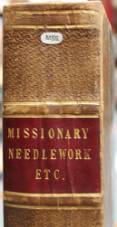Missionary Needlework etc. Collected by the Rev. G. E. Smith (1805-1881)]
by Sarah Vincent (Electronic Resources Librarian)
Recently unearthed from the collections by a slightly bemused librarian, Missionary Needlework etc., illustrates the importance of not judging a book by its cover, or indeed its title. There is a singular lack of needlepoint contained within the marbled covers of this 18th century scrapbook; it has instead been repurposed to hold a lovingly compiled collection of natural history drawings, cuttings, notes and photographs collected by the Reverend Gerard Edward Smith.
Smith was born in Camberwell in 1805. He studied at Oxford and, after being ordained in 1829, became Vicar of Sellinge, Kent. After marrying Isabella March Clark in 1935, Reverend Smith moved to the North of England and spent the next 40-ish years as the Vicar of Cantley, Ashton Hayes and Osmaston, respectively, before retiring to Ockbrock.
Throughout his career, Smith enthusiastically pursued a side-line interest in the study of the natural world. He was a keen amateur botanist and, alongside his wife, spent time collecting, drawing and painting examples of local flora. He even found time to author several books on British botany, which are also held in the NHM Library.
Smith’s interest in the world around him did not end with plants, as demonstrated by Missionary Needlework, etc., which is a highly personal scrapbook composed of a brilliantly diverse and eclectic range of zoological articles, paintings, prints and illustrations (many of which were apparently drawn by Smith himself). These items have been meticulously pasted in place and arranged systematically in rough order of biological complexity. It begins with a rather charming human skeleton and finishes with some less charming parasitic worms, taking in such marvels as creepily smug dolphins and beautifully painted beetles along the way.
We received Missionary Needlework etc., as a donation from Aimee Clark in 1933. Aimee’s aunt, May Senior Clark, was presumably a relative of Isabella’s and received Smith’s natural history collections following his death in 1881. From Aimee’s introductory letter, we can gain some insight into Smith’s character: apparently he was very popular with younger members of the family and was regarded as ‘a real playfellow’.
This description is backed up by one of the most charming items contained in the scrapbook, an inserted miniature pamphlet about bats, which was illustrated and written by a 21-year old Smith and dedicated to ‘the amusement of my little friends’.
This pamphlet covers a range of fascinating bat-themed topics and provides valuable advice to those travelling in areas inhabited by the vampire flitter mouse, namely to sleep with your feet covered up in order to avoid being bitten and ‘passing from a state of sound sleep to that of death’.
Fittingly, the pamphlet closes with a poetic description of the incident that inspired its creation, a home invasion by a rather confused long-eared bat:
‘Prithee look dear Papa! What a wonder is here!
A winged little mouse, it would seem, I declare!
Where the door was wide opened, I saw it fly in,
So quite certain I am that it flits thro’ the air!’



